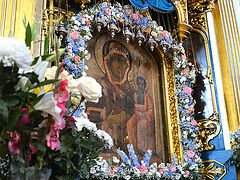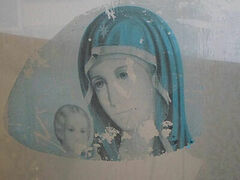PPEARANCE OF THE “WEEPING” ICON OF THE MOTHER OF GOD IN ROMANIA

This icon of the Mother of God was in a church in the Orthodox Theological Seminary at the Romanian Sokolsky Monastery. In February 1854, it gained renown for the remarkable miracle of shedding tears.
Following the Liturgy served on February 1 in the seminary church, a frightened member of the clerical staff ran up to Hieromonk Isaiah, the ecclesiarch, and said that the icon of the Mother of God was weeping. Several of those serving immediately ran to the church. There they all clearly witnessed, still wet, tears running down from the eyes of the Mother of God.
Bishop Philaret Skriban, the seminary rector, also witnessed this miracle. He removed the icon of the Mother of God from its frame, carefully examined it, used a towel to wipe off the tracks of the tears, and put the icon back in its place. Then, after directing everyone to leave the church, he looked around throughout the church, and then locked it up.
Several hours later, the seminary professors and instructors accompanied their rector into the church for Vespers, and all were amazed to see the same miraculous flowing of tears from the eyes of the Theotokos depicted on the Icon. The seminary rector immediately served a Moleben and Akathist to the Mother of God.
Soon, all of Romania learned of this miraculous event, and people from all parts of the country began to arrive at the Sokolsky Monastery to bow down before the newly revealed miraculous Icon of the Theotokos. The marvelous flowing of tears sometimes happened every day, and sometimes two, three, or four days apart. As a result, many people were able to see at first hand the actual miracle of weeping and could personally bear witness to it. Those who did not see the actual miracle could bear witness to it by seeing the tracks of the dried tears on the surface of the icon.
Yet, there were those who doubted...
The Weeping Icon of the Mother of God appeared during the Crimean War. Because of that war, the Principality of Moldavia was occupied by Austrian troops. Their commanding officer, General Paar, sent a staff officer to the Sokolsky Monastery with instructions to carefully investigate the reported miracle and to give a report of his results.
The colonel obeyed the orders. In the Monastery, he made a thorough examination of the Weeping Icon of the Mother of God. At the time, it was not weeping. Finding nothing out of the ordinary, he put the icon back into its frame. Then he took a lighted candle, and with the help of the candle made a careful examination of the face of the Mother of God. Suddenly two little diamond-bright tears shone in the eyes of the Mother of God, and tears began to flow. The officer recoiled in terror, and exclaimed, “It’s weeping! That is a great miracle! Fathers, pray to God!”
The colonel reported what had transpired to his commanding officer. His report on the miraculous flowing of tears from the icon is of unquestionable importance, for he had come to Sokolsky Monastery without any faith in the possibility of such a miracle, but he left with faith, convinced that it was an indisputable fact.
This was not the only evidence that a true miracle had taken place. There were many other eyewitness accounts, including accounts by individuals whose sincerity there would be no reason to question.
The account provided by Bishop Melchizedek of Romania merits particular attention. He was one of the first to be an eyewitness to this miracle, and at the time was a professor at the seminary in the Sokolsky Monastery. Reminiscing thirty-five years later about seeing tears pour from the eyes of the Mother of God, this elder said that for a long time he pondered the question: What do these tears of the Mother of God signify? He became convinced that in times past there had also been such icons, which from time-to-time wept tears, and that similar events always presaged difficult trials for the Christ’s Church and for the homeland.
History supported this elder’s conclusion. Soon after the miraculous shedding of tears, the Moldavian Principalities were subjected to severe trials. The Sokolsky Monastery also suffered great difficulty. It was as important to Romanians as the St. Sergius Lavra is the Russian people. Romania’s great religious and educational center was destroyed. The seminary was moved to Jassy, and the local instructors and monastics were dispersed. Thus, where the glorious historical seminary had stood, serving for almost a century as a nursery for religious education, there remained only a single, small, elementary school.
2/14/2024



No hay comentarios:
Publicar un comentario